by Winding Pathways | Jul 31, 2014 | Reflections/Profiles, Wonderment
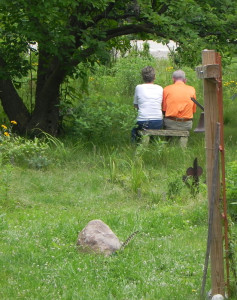
Enjoying quiet after a stressful day.
A home and yard can be a place to find peace and tranquility in a stress filled world. Many recent studies reveal that being embraced by nature’s beauty offers stillness that calms the soul. But, it does more.
Being in nature lowers blood pressure, stimulates the imagination, provides exercise and satisfaction, and nurtures creativity. Many people trek to distant parks, wildlife refuges, and wilderness areas to harvest nature’s peace. All good ventures.
Winding Pathways encourages people to create a wonderful natural area in the place where we spend the most time – at home.
The tiniest yard or even an apartment balcony can be coaxed into a space of beauty and peace.
Winding Pathways offers tips on how to transition a mowed and sprayed yard into one that provides the tranquility we need.
Your yard is the best place to unwind after a hectic day, and Winding Pathways will help make that yard a wondrous place.
There’s more to tranquility than the yard. We’re all bombarded by news reports of massive home-destroying storms and millions of people left without power. Winding Pathways will help you build peace of mind by showing you how to prepare for power outages, tutoring you in how to grow and find food in the yard, and helping you remember how to enjoy the simple quiet solitude in the back yard.
Your yard is also a place for adventure, especially for children and grandchildren. Bumblebees, woodpeckers, clover rings night crawlers, opossums and more are all fascinating to youngsters. A yard with places to explore, quiet nooks to hide in, and curious things to discover is a place of joy.
Winding Pathways will encourage you to craft your yard for your tranquility and a child’s wonder.
Co-owner Marion Patterson is the “tranquility guide.” In addition to sharing tips on how to nurture and enjoy a diverse and ecologically healthy yard she encourages you to connect with your inner space. Among the options is creating a contemplative labyrinth, exploring the quiet spaces within ourselves, and participating in spiritual retreats.
by Winding Pathways | Jul 14, 2014 | (Sub)Urban Homesteading, Foraging
Before the invention of agriculture nearly all people were expert hunters and gatherers. Although our world still provides plenty of wild food, free for the taking, few modern people even realize that delicious food goes unharvested in nearly all unsprayed yards.

Purslane
Knowing how to identify and prepare wild foods offers opportunity for new culinary experiences, reduces the grocery bill, and gives people who know how to forage the comfort of knowing that they can find food and will eat should there be a major disruption in modern food distribution.
Winding Pathways offers on its Website common free foods seasonably available across much of North America and beyond. Some of the best edible plants live in urban areas worldwide. They are likely in your back yard if you don’t apply herbicide. Often we simply call them “weeds”.
After years of foraging, preparing, and eating dozens of wild foods we categorize them as follows:
- The Best: These are common, hardy plants that are easy to identify, harvest and prepare, and are truly delicious.
- The Marginal: These are often also common but are either difficult to harvest or prepare and/or aren’t the tastiest foods. They are great to know in an emergency but few people will eat them routinely.
- The Hunger Foods: Many common plants are edible but are normally challenging to harvest and prepare. They have little taste or are not very appealing. They are worthy to know only because eating them would be better than starving!
Winding Pathways will prioritize information on the Best category and occasionally add information on the others.
But first a word of caution. Edible wild plants share the yard or nearby park with toxic cousins. Always follow these rules before eating any new wild plant:
- Be absolutely certain you have correctly identified the plant and confirmed its edibility. Consult three independent sources before eating. For example one source could be a guidebook, such as the Peterson Guide to Edible Wild Plants. Another could be gleaned from a reliable Internet source. A third might be provided by a local foraging expert. If there is a nature center in your area staff can probably give you contact information on local experts and may even sponsor a foraging program. A good way to start is by identifying a plant in a paper book and then simply Googling it to access electronic information.
- The first time you eat something new go easy. Eat only a small amount. Some people are allergic to even the most common foods. Eating small quantities tests the body to make sure it likes it.
- Make sure any harvested wild plant comes from a place that has not been chemically sprayed. Be sure to wash all gathered foods well.
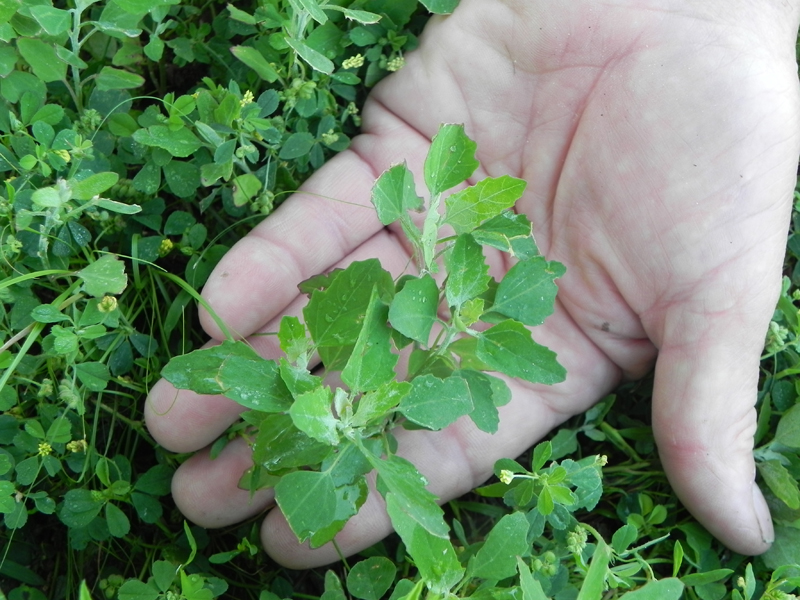
Lamb’s quarter
Winding Pathways three favorite late summer edible plants – those that are common, easy to find and prepare, and taste great – are:
- PURSLANE, an old world weed widely cultivated in India. It’s fleshy stems and leaves hug the ground and are most common in hot, poor soil. Young leaves are delicious raw in salads. Stems and leaves can be steamed or pickled.
- WILD BEET OR AMARANTH is a weed in nearly all vegetable gardens. It makes a delicious steamed vegetable when cooked like spinach. Season with butter, salt and pepper as desired.
- LAMB’S QUARTERS. Few gardens lack lamb’s quarters growing between vegetable rows. Young plants are delicious when steamed like spinach and can also be eaten raw.
Coming soon: American Indians knew a good thing when they tasted it. Acorns were an important dietary staple for them. Check back for information on harvesting and processing acorns.
by Winding Pathways | Jul 14, 2014 | Flowers/Grasses, Nature, Weeds
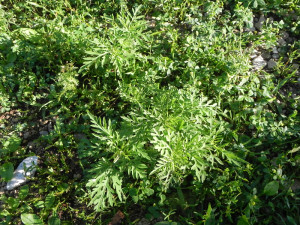
Common Ragweed
Late summer is the dreaded hay fever season! Ragweed is the prime culprit.
Two species of ragweed account for most of the misery. Both are annuals that reseed each year. The seeds only need a bit of bare ground to sprout. They are not fussy, thriving in nearly any type of soil.
True to its name, Common (sometimes called Eastern) Ragweed can be found nearly anywhere people live, especially cities. It can be a prostate plant hugging the ground or sidewalk edge or grow to two or three feet tall on the edge of a yard. Giant (sometimes called Western) Ragweed is less common in suburban and urban areas and can grow to upwards of eight feet tall. It’s abundant on the edge of farm fields where it often forms large thickets. In urban areas Giant Ragweed is most likely found in industrial areas and along railroad tracks. Despite their names either species can be found nearly anywhere in North America, where they are a native plant. Unfortunately ragweed has been introduced to Japan.
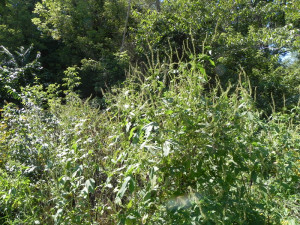
Giant Ragweed
Ragweed causes human suffering because in late summer plants produce green flowers that release millions of pollen grains to the wind. Allergic people react after breathing in the tiny grains, which can blow for miles from the parent plant.
Goldenrods are frequently blamed for causing hay fever because of an unfortunate coincidence. They bloom during hay fever season. Goldenrod flowers are a bright yellow, designed to attract pollinating insects. They do not release pollen into the air and are unjustly blamed for causing human misery.
Despite causing hay fever, ragweeds have ecological value. They are a pioneer weed that quickly becomes established on bare soil. Roots hold the soil, preventing erosion. Within a few years ragweeds usually vacate the spot as more stable perennials move it. Ragweed seeds are devoured by many bird species such as quail.
As a general rule any plant that produces unshowey flowers is a wind pollinator that could cause human allergies. This includes many grass and tree species as well as ragweed. In contrast plants that produce colorful showy flowers are normally insect pollinated and don’t cause sneezing.
by Winding Pathways | Jul 14, 2014 | Children/Play, Wonderment
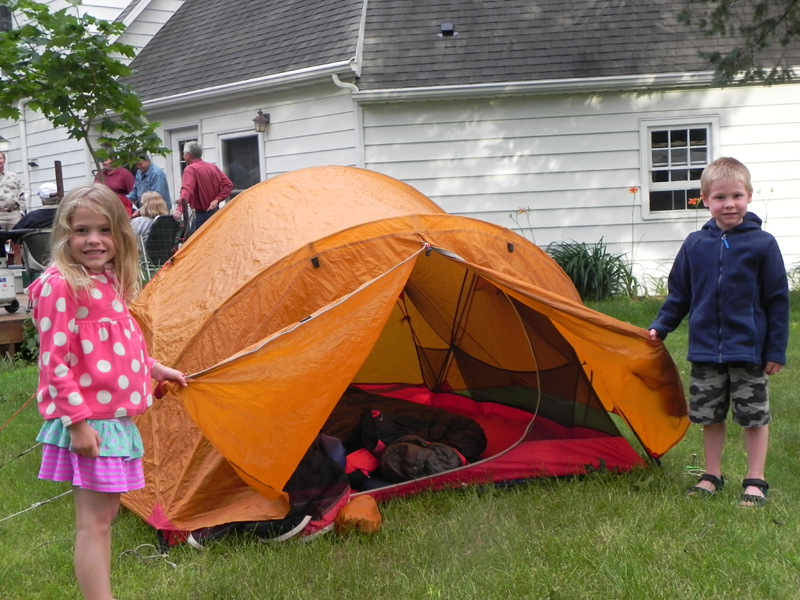
Our son and daughter loved kid camping in the back yard. Warm month Holidays and each summer, usually a week or so before school started, they’d invite a few friends for an overnight adventure.
Today’s well insulated and screened homes keep out frigid temperatures and summer insects. Unfortunately insulation also masks nature’s wondrous late summer sounds.
Children take to camping out. Even a tiny backyard can easily be converted into a temporary campground. Equipment is simple. August weather is warm enough that a sheet and blanket eliminate the need for a sleeping bag. All that’s needed is a simple inexpensive tent, blankets, flashlights, a pillow and some parental guidance.
We won’t forget the night our daughter, then about eight, and her friends came running back into the house after “WHOO WHOO COOKS FOR YOU!” loudly entered their tent from a nearby elm. We went out with a flashlight seeking the elusive, but common, barred owl.
After catching a fleeting glimpse of the bird flying off the girls settled down in the tent to giggle, chat, and maybe even get a little sleep that night.
Here’s what you need to help your child and friends enjoy a night of kid camping right out the back door.
A simple inexpensive tent with a sewed in floor and mosquito netting. Being in a tent gives a feeling of security while keeping out bugs
- Flashlight
- Insect repellent
- Blanket and sheet to ward off evening chilly weather. An inexpensive sleeping bag is better
- Pillow
- Snacks and bottle of drinking water.
- Teddy bear and anything else that gives comfort to a sleeping child
The kids may want to bring a cell phone and games into the tent, although these might distract from listening to the sounds of the yard.
Parents can help make kid camping more entertaining and fun by guiding the kids in simple activities that might include:
FIRE: Gather dry sticks in the yard and neighborhood. Dig a small hole in the yard and build the fire in it. Show the kids how to build a tiny fire. Instruct them in fire safety. Grill hot dogs and marshmallows on sticks gathered from the yard. Enjoy story telling.
STARS: Unfortunately, light pollution and smog limit astronomy in most cities, but the major stars can usually be seen. Help the children find the Big Dipper and North Star. A free phone app helps initially until children are used to searching the night sky.
WALK IN THE DARK: Take a short walk in the dark yard and encourage kids to be comfortable without the pervasive lights of today’s society. Sit for several minutes in the dark yard to let your eyes adjust to night vision. Enjoy the sounds and feel of the evening. You may be surprised how your senses clue you in to the wonders of the night.
ENJOY SOUNDS: August is cricket and cicada month. But lots of creatures call from even the smallest and most urban yard. If lucky owls will call.
Follow up the night’s adventure with breakfast and conversation on what the kids heard and saw on their night outside.
by Winding Pathways | Jul 14, 2014 | Bugs, Nature, Pests
Many people believe that long cold winters freeze ticks to death so abundance of these pests will be lower the following summer. That isn’t always the case. Plenty of ticks survived the frigid 2013/2014 winter and have appeared on pets, wildlife, and people the following spring and summer.
Ticks are more than mere pests. They can carry serious diseases. Several species are common in any given part of the country. Most are larger species that are about the size of a pencil eraser. Less easy to spot are tiny deer ticks that can carry the debilitating Lyme Disease. Sometimes they are so small that people are bitten without even realizing it.
The recreational, inspirational, and exercise benefits of being outdoors are immense, and no one should stay inside for fear of ticks, but everyone should take precautions to reduce odds of being bitten by a tick and catching a nasty disease.
Ticks are arachnids. They have eight legs, rather than an insect’s six. Fortunately, insect repellents also repel ticks, and some special sprays are designed to kill them. Repellents are generally safe to apply to the skin but don’t last long. Tick killing sprays are meant to be applied to clothing, not skin, and tend to remain effective through a few washings. We use a combination of both when outside in areas where we suspect ticks lurk.
After spending time outdoors everyone should conduct a tick check on their body. Although commonly believed, ticks do not drop down on people from overhead branches. They normally cling to a plant and simply step onto a person, dog, or wild animal when it brushes by. Usually a tick will walk around on a person, sometimes for hours, before biting. Ticks found walking on a body pose no health hazard and can be plucked off and flushed down the toilet. Only those ticks that have penetrated the skin pose a health hazard. If a dug in tick is found on the body it’s a good idea to consult a medical authority and follow the advice given.






